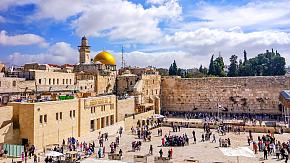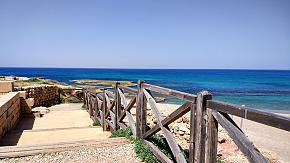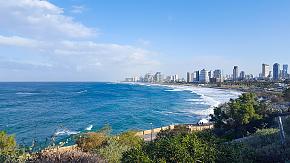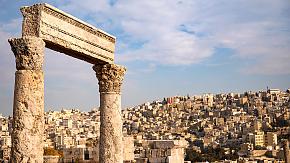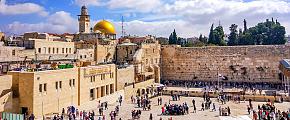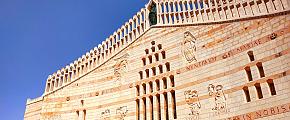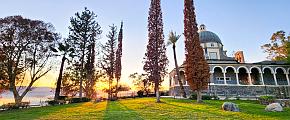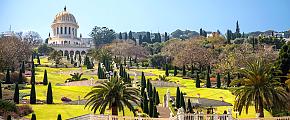Introducing Israel: Tel Aviv, Jerusalem, and Bethlehem
The State of Israel, lying at the south-eastern end of the Mediterranean Sea, is relatively new as a country, but the land it sits on is ancient and has been witness to events and history of world changing importance. Of great significance to Judaism, Christianity and Islam, it attracts large numbers of visitors of each of these three faiths but also those of other or of no faiths.
Since the modern State of Israel was founded in 1948, millions of Jewish believers have immigrated to the country giving it an international flavor. Although Hebrew is the official language with Arabic being recognized as having special status in the state, many other languages can be heard, including Russian, French and Amharic. English is widely spoken as a second language and, for example, road signs are often in Hebrew, Arabic and English, especially in the major cities.
Today, I will attempt to introduce some of the highlights of Israel, but with so many to choose from, it's going to be a difficult task.
Israeli Currency
First let me give you some useful information. Since 1986 Israel has used the Israeli New Shekel, usually abbreviated to just Shekel. It uses the symbol ₪ and the official international currency code is ILS, although INS is sometimes unofficially used. There are four banknotes: ₪20, ₪50, ₪100 and ₪200 and the shekel is subdivided into agora (plural agorot). There are coins worth 10 agorot, ₪½, ₪1, ₪2, ₪5 and ₪10. The exchange rate as of August 2026 was ₪10 = $3.
Let's start where most visitors' trips to Israel begin.
Tel Aviv-Yafo
More commonly referred to just as Tel Aviv, this coastal city, Israel's economic hub, is near the location of Ben Gurion International Airport (IATA: TLV), Israel's main international airport, 20 km (12 mi) to the southeast. The airport has good rail and bus services to the city and beyond, but take note that trains and most buses do not run on the Sabbath (roughly from early Friday evening until late on Saturday night). Taxis are available, but it is best to try to time your arrival to a more convenient day.
Tel Aviv has been called "the city that never sleeps" because of its nightlife and party atmosphere. Bars and clubs can be found everywhere, but most popular are those in the Tel Aviv port area. The city is also well known for its welcoming LGBT vibe and is home to Asia's largest "pride parade" which attracts over 200,000 participants and visitors each year. The next parade is scheduled for Friday, June 13 in 2026 and will kick off at 5 am.
The city is also the location of some of Israel's best beaches and has been named 9th best beach city in the world by National Geographic. All of the 13 official beaches have good facilities including changing rooms, bathrooms, lifeguards, games rooms etc. They also have sun umbrellas, chairs, sunbeds and beach lockers to rent and some even have beach libraries! They have snack and drinks stalls and Tel Aviv municipal authorities have set all prices for rentals to ensure visitors are treated fairly. A beach umbrella or chair will cost ₪6 and a sunbed ₪12. (August 2023 prices)
Beach catering prices are also set: a bottle of mineral water is ₪7, a humus pita sandwich ₪12, coffee ₪5, water melon ₪25, French fries ₪30, local beer ₪21 etc. These prices apply for purchases made directly at the beach bars and shacks. Prices for delivery to your chair or sunbed will be higher.
Metzitzim Beach is the most family oriented beach, having shallow waters and vigilant lifeguards. There is catering in the form of a bar and restaurant (open 7 am until everyone goes home) and all the usual expected facilities. The beach can be busy on weekends and public holidays. Nordau Beach is a sex-segregated beach catering to the more conservative, religious locals and visitors. It is women only on Sundays, Tuesdays and Thursdays and men only on Mondays, Wednesdays and Fridays. On Saturdays, the Sabbath, the beach is non-segregated and attracts many young couples. No dogs, no parties or water sports are allowed. Givat Aliya Beach, also known as Ajami Beach is a less developed beach in the south of Tel Aviv, but that can be a good thing, too. It is quieter than most and the view here is spectacular, especially at sunset when many people go horse riding. It is a favorite spot for people to play backgammon or chess and tables and game equipment can be borrowed free of charge. Swimming here is only for the stronger swimmers as the tides can be powerful.
 A beach in Tel Aviv
A beach in Tel Aviv
Whatever kind of beach you like, you will be sure to find one to suit your needs here on the 14km / 7 mile long city coastline.
If you are vegetarian or vegan, you will also be happy here. Tel Aviv has the highest per capita number of vegans of any city in the world and has many vegan restaurants. The city also has a great non-vegan restaurant scene offering both traditional Israeli cuisine and international cuisines.
Jerusalem
54 km / 34 miles (as the crow flies), 68 km / 42 miles (by road) east of Tel Aviv is the historic city of Jerusalem. Inhabited for at least 5,000 years, it is one of the world's oldest cities but perhaps more importantly it is the center of three of the world's largest religions. Of most interest to visitors is the Old City, situated in East Jerusalem in the West Bank. The number of important religious sites here is almost overwhelming, but here are some of the most important.
The Mount of Olives, so-named as it was once covered in olive trees, overlooks East Jerusalem and is important to both Judaism and Christianity. The Old Testament and Judaic texts refer to it as being visited and climbed by David whose citadel can be found nearby. The New Testament mentions it several times and in Acts 1, it is said that this is where Jesus ascended to heaven. The mount has been a Jewish cemetery for over 3,000 years and many devout Jews still wish to be buried here as it is said in the Old Testament that this is where the Resurrection will commence when the true Messiah comes.
 A panoramic view of Jerusalem from Mt. Olive
A panoramic view of Jerusalem from Mt. Olive
At the foot of the mount is Gethsemane, in which is the garden of which Judas is said to have betrayed Jesus leading to his crucifixion. In fact, there are four different sites here as to where this may have happened depending on which branch of Christianity is followed. The Eastern Orthodox Church also believes the tomb of Mary lies here in what is now the Church of the Sepulchre of Saint Mary, also known as the Tomb of the Virgin Mary.
The Via Dolorosa (Latin for "Way of Sorrow") is traditionally believed to be the route Jesus followed while carrying his cross to the Crucifixion. The 600 meter / 2,000 foot long route runs from what was the Antonia Fortress, supposed site of Christ's trial by Pontius Pilate to the Church of the Holy Sepulchre, the site of the crucifixion and the empty tomb of Jesus from which he is said to have been resurrected.
 The Church of the Holy Sepulchre
The Church of the Holy Sepulchre
Today, Christian pilgrims and visitors walk the route passing nine Stations of the Cross, marking various parts of Christ's walk as related in the Gospels. The Church of the Holy Sepulchre, one of Christianity's most sacred sites, was originally built in the 4th century AD, but has been destroyed and rebuilt several times over the years, as well as being restored in very recent times. The church is open to all visitors, regardless of faith, from 05:00 to 20:00 from April to September, then October to March is open from 04:00 to 19:00. There is no charge to enter.
Note that the church can get very busy and waits of an hour or more to enter are not uncommon. It is recommended that you get there as early as possible in the morning. Easter is the busiest time by far. Probably best avoided then. As with all religious sites appropriate behavior and modest dress is required.
The most holy site in Judaism, Temple Mount also lies in the Old City and is where all Jewish worshipers face when praying. This was the site of the two most revered temples of Judaism: Solomon's Temple, built around 1000 BC and destroyed by Nebuchadnezzar II, King of Babylon in 587 BC; and the Second Temple built in 516 BC and destroyed by the Romans in 70 AD as a punishment for a Jewish revolt.
Temple Mount is also sacred to Islam and is considered to be the site of the third greatest mosque after those in Mecca and Medina, both in Saudi Arabia. This duality has caused great tension and even conflict over the centuries, a situation which is still largely unresolved. At present, the site is controlled by Islamic authorities, but security is the responsibility of Israeli forces. Jews and Christians are allowed to visit the mount but, to avoid conflict, are forbidden from carrying out any religious activities there, including carrying religious texts or praying. In fact many strict Jews do not wish to enter the mount as they fear it would be sacrilegious to accidentally step on the site known as the Holy of Holies, where the Tabernacle and the Ark of the Covenant, depository of the ten commandments, once stood. Others refrain from visiting as the security situation means that they cannot carry out the required purity rituals for entering the area.
The Dome of the Rock is a well known landmark and symbol. This beautiful, octagonal, Islamic shrine on Temple Mount was first built between 691 and 692 AD but destroyed by the Romans. The current dome dates to 1023, although the gold plating was added as recently as 1961 and renovated in 1993. Some Muslims believe the dome is the spot from which Muhammad ascended to heaven accompanied by the angel Gabriel, although others contend that took place from the nearby As-Asqa Mosque.
 The Dome of the Rock
The Dome of the Rock
Al-Aqsa Mosque, also on the Mount, is the third most important mosque to Muslims after the Kaaba in Mecca and Al-Masjid an-Nabawi in Medina. Believed to have originally been built during the reign of the Muslim caliph Umar (584-644 AD), a contemporary of Muhammad, the mosque has twice been destroyed in earthquakes and rebuilt. During the Crusades, it was used as a palace and as stables.
Due to the high sensitivity of this site, access to the Al-Aqsa Mosque is variable and unpredictable. If you wish to visit, it is best to check locally with your guide or hotel information desk for the latest information.
Temple Mount is surrounded by walls, some of which remain in various states of repair. Most significant is what is known as the Western Wall, Wailing Wall, or Kotel in Hebrew and in Islam as the Buraq Wall. In fact, what can be seen today is only part of the much longer Western Wall, most of which is hidden behind much newer constructions. Built by the Romans under Hadrian, the wall is the closest strictly observant Jews can get to the sacred Temple Site inside. They gather here to pray and mourn for the loss of the temples and the general historic treatment of people of their faith. The term "Wailing Wall" is not used by Jewish people and many consider it derogatory.
 The Wailing Wall
The Wailing Wall
Jerusalem is also the site of two important museums. The Israeli Museum, established in 1965, is dedicated to displaying the archaeology of the Holy Land, and Jewish art and life. It has the Shrine of the Book, an urn-shaped building which houses the Dead Sea Scrolls and other artifacts discovered at Masada. The museum is also a world-class art gallery featuring art from Israel and the rest of the world, from ancient to modern times.
Address: Israel Museum, Derech Ruppin 11, Jerusalem. Tel: 02-6708811
Opening Hours: Monday, Thursday, and Saturday 10:00 to 16:00; Tues 16:00 to 20:00; Friday 10:00 to 14:00. Closed on Wednesdays and Sundays. Please check the exact opening hours before your visit.
During Hanukkah (in 2025, from sunset on December 14 to sunset on December 22) much shorter opening times are applicable. Check locally.
Tickets are ₪54 for adults, ₪39 for students and ₪27 for children (5-17), although children are admitted free on Tuesdays and Saturdays.
Yad Vashem, the second most visited Israeli tourist site, after the Western Wall, is Israel's official memorial for the those who died in the Holocaust, both Jews and non-Jews and is a research center studying the Nazi Holocaust and other genocidal atrocities in the hoping of preventing any recurrences. Among other memorial buildings, it holds archives, a library, a publishing house, and an educational center, and the International School/Institute for Holocaust Studies. It also contains the official Israeli Holocaust History Museum, first opened to the public in 1957, but rebuilt and reopened in 2005. The museum aims to tell the story of the individuals who were murdered, instead of lumping them all together into one meaningless figure. According to the chairman of the museum a visit involves "looking into the eyes of the individuals. There weren't six million victims, there were six million individual murders." It attempts to achieve this through the personal stories of 90 Holocaust victims and survivors, and displays of around 2,500 personal items including artwork and letters donated by survivors and others.
Address: Yad Vashem,Har Hazikaron, Jerusalem; Tel 2-6443400.
Entry to the Holocaust History Museum is free and opening times are Sunday to Thursday, 09:00 to 16:00; Friday and Holiday eves, 09:00 to 13:00. Closed Saturdays and Jewish holidays. Entrance ends one hour before stated closing times.
Note: Children under 10 are not admitted to the museum.Visitors must be reserved online in advance.
Bethlehem
About 10 km / 6 miles south of Jerusalem, in the central West Bank, lies the city of Bethlehem, another important site to both Christianity and Judaism. First recorded in around 1350 to 1330 BC, Bethlehem (the name means House of Bread) is believed to be the birthplace of both the old Testament King David and that of Jesus as recorded in the New Testament Gospels of Matthew and Luke.
The Church of the Nativity, or Basilica of the Nativity was originally built by the Roman Emperor, Constantine the Great in around 333 AD, but destroyed in the early 6th century during a revolt. A new citadel was built by Emperor Justinian who ruled from 527 to 565. Despite some additions and restorations this is still what you can see today. Underneath the main altar of the Church is a cave known as the Grotto of the Nativity, said to be the birthplace of Christ, although many bible scholars and historians dispute this. The supposed spot of the birth is marked by a silver star and the Latin inscription Hic De Virgine Maria Jesus Christus Natus Est, meaning "Here Jesus Christ was born to the Virgin Mary" Also in the citadel is the Milk Grotto, where Joseph, Mary and the baby Jesus hid during Herod's slaughter of children before escaping to Egypt; three monasteries one Greek Orthodox, one Armenian Apostolic, and one Roman Catholic; and has smaller churches such as the Chapel of Saint Joseph in memory of the angel telling him to flee with Jesus to Egypt and the Chapel of the Innocents, commemorating the children killed by Herod.
Opening Times: April to September, 06:30 to 19:30; October to March, 05:30 to 17:00. The Grotto is closed on Sunday mornings.
Rachel's Tomb, in the north of Bethlehem, is Judaism's third most sacred site and is mentioned in the Jewish Tanakh, the Christian Old Testament and in Muslim literature. Rachel, wife of Jacob is said to have died in childbirth and her tomb has now become a pilgrimage site, especially for married Jewish women who have difficulty conceiving.
Technically open for 24 hours from Sunday to Friday. Closed Saturdays and Jewish holidays. Admission free.
There is much, much more to be seen and to do in Israel, but once again space is limited. I'll be back with more. Whether you are a believer or not, the stories and events from this part of the world have shaped our world's culture and it is an unforgettable experience to see the places for yourself.
If you would like to visit any or all of the sites I've mentioned, or any others I didn't get round to this time, then please remember, if you just send us the details of what you would like, one of our travel experts at Odynovo will get back to you within 24 hours with a free, personal customized itinerary for your consideration.
Quick Question
Related Posts You May Like
What Our Clients Say
Explore the latest verified reviews of Odynovo's travel services on Tripadvisor, Google, Trustpilot, Product Review and more trusted platforms.

